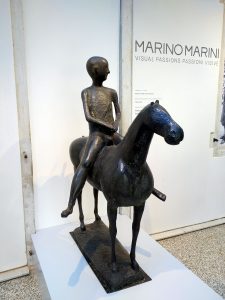This exhibition presents major sculpture by Marino Marini (1901–80) and selected works by artists such as Giacomo Manzù, Henry Moore, Pablo Picasso, and Auguste Rodin, as well as Etruscan objects and Italian sculptures from the 15th century. Visual Passions contextualizes Marini’s oeuvre in a broader art historical framework and establishes a focused and innovative dialogue between his production and the sculptural traditions he referenced.
Marino Marini is the best known Italian sculpture artist of the 20th century and the most famous as well: many exhibits have been organized in his name worldwide.
His works will be first shown overseas in 1944 at the time of the exhibit ‘20th century Italian art’ at the MOMA in New York. He’ll be later acclaimed in 1950 when the art gallerist Curt Valentin organized in New York his true first personal exhibit in the USA. Marini’s success was immediate and his debut on 57th Street brought him international acclaim. What distinguished Marini in the eyes of the American public was his calibrate balance between tradition and modernity
His fame then overcome art confines when his works were shown in major American movies like ‘Sabrina’ (1954) by B. Wilder, ‘Guess who’s coming to dinner (1967) by S. Kramer and ‘Play it again Sam’ (1971) by H. Ross. Preeminent figures like Nelson Rockefeller and Igor Stravinskij ask Marino to be portrayed by him while the magazines Life and Newsweek further diffused his fame in their articles.
During the 50’s Marini’s works were exhibited in London, Hannover, Hamburg, Munich. In 1952 he won the first prize for sculpture at the Venice Biennale. In 1959 the statue called ‘Horse and Rider’ was unveiled in the city of The Hague in Holland.
In the 30’s and 40’s Marino focused on the formulation of a ‘pure form’ recovering and re-elaborating with a modern eye the Etruscan and medieval tradition. The present Guggenheim exhibit dedicates the first rooms to that first approach of Marini to art work.
Marini from now on will dedicate his attention mostly on the subject of the man riding on horse. In his words ‘’All of humanity and nature reside in the figures of the horse and the rider of every age. This is my way to tell about History. At first there is harmony between them but later on, above all after IIWW, the world of machines brakes in violently fracturing this symbiosis in a most dramatic way although not less alive and vitalizing.’’
Stating from ’43 we see a change in the plastic rendering of the subject, the relationship between horse and rider becomes dramatic and conflictual. In the post-war years Marino stresses the dramatic tension of his works deforming them into a rough and bare-born surface.


